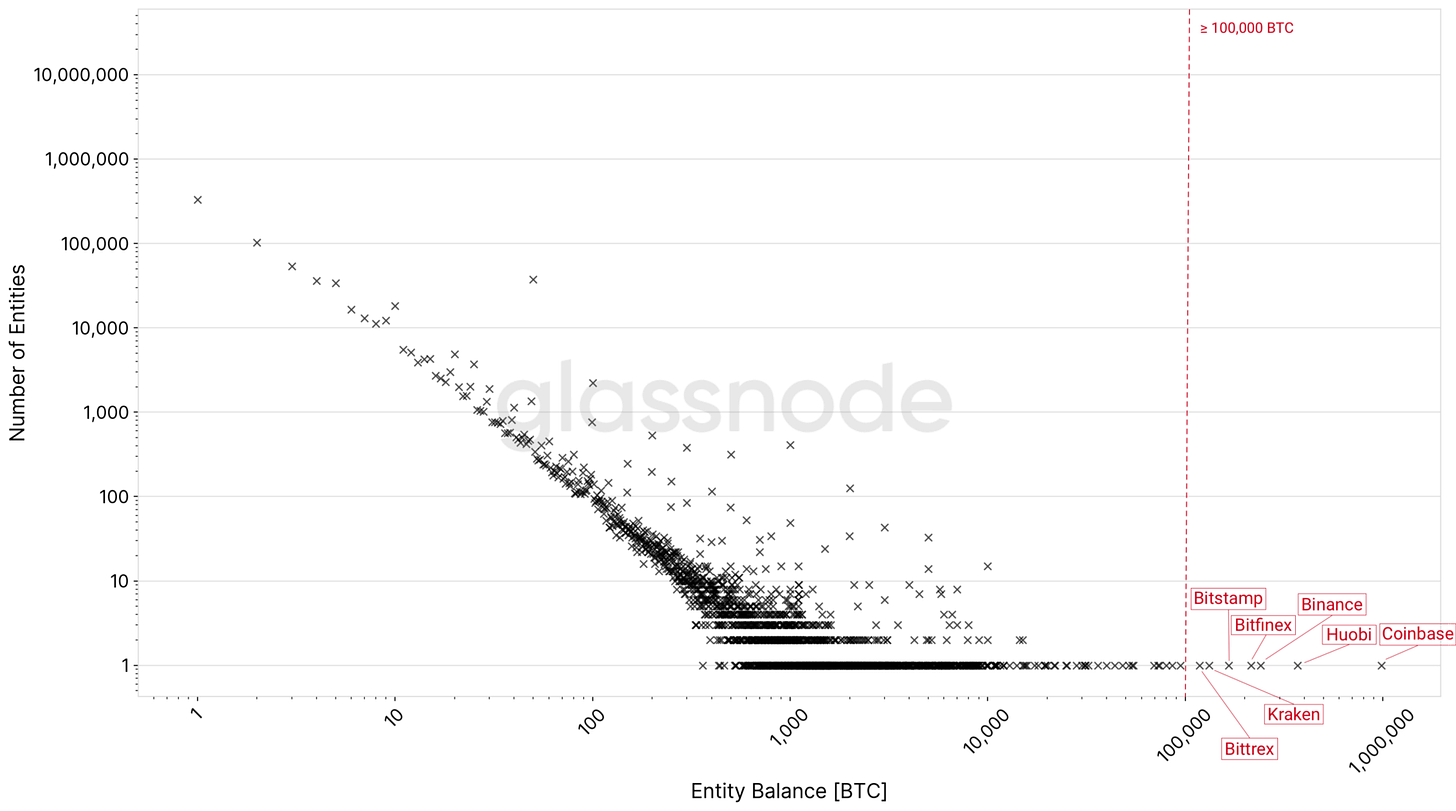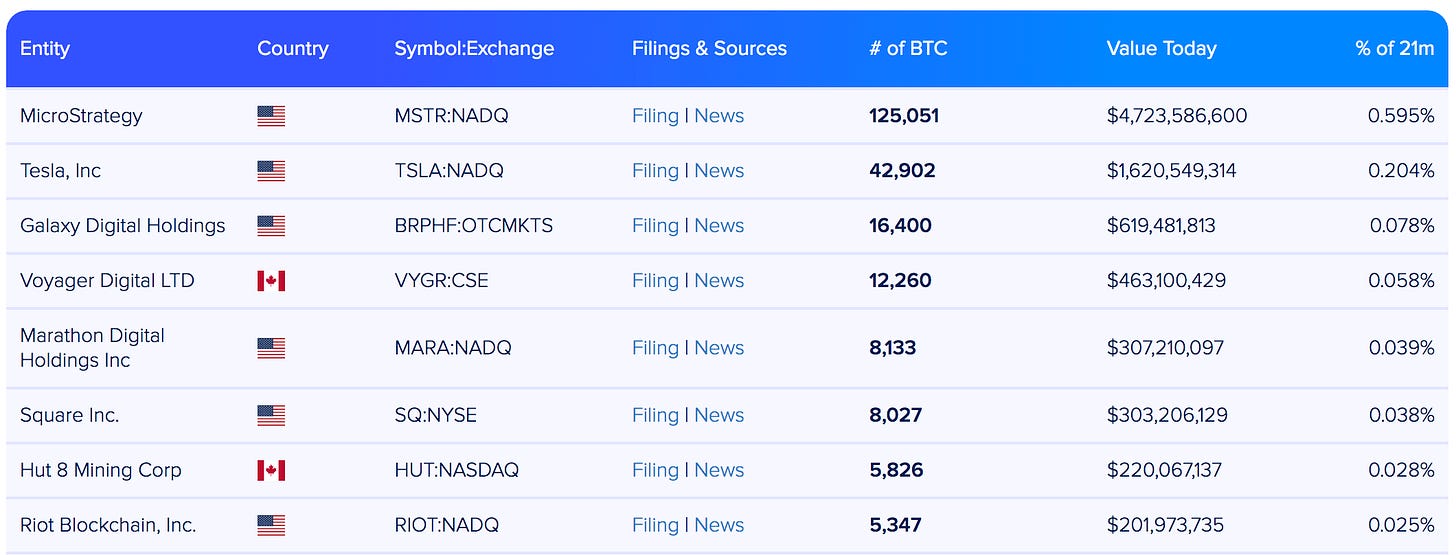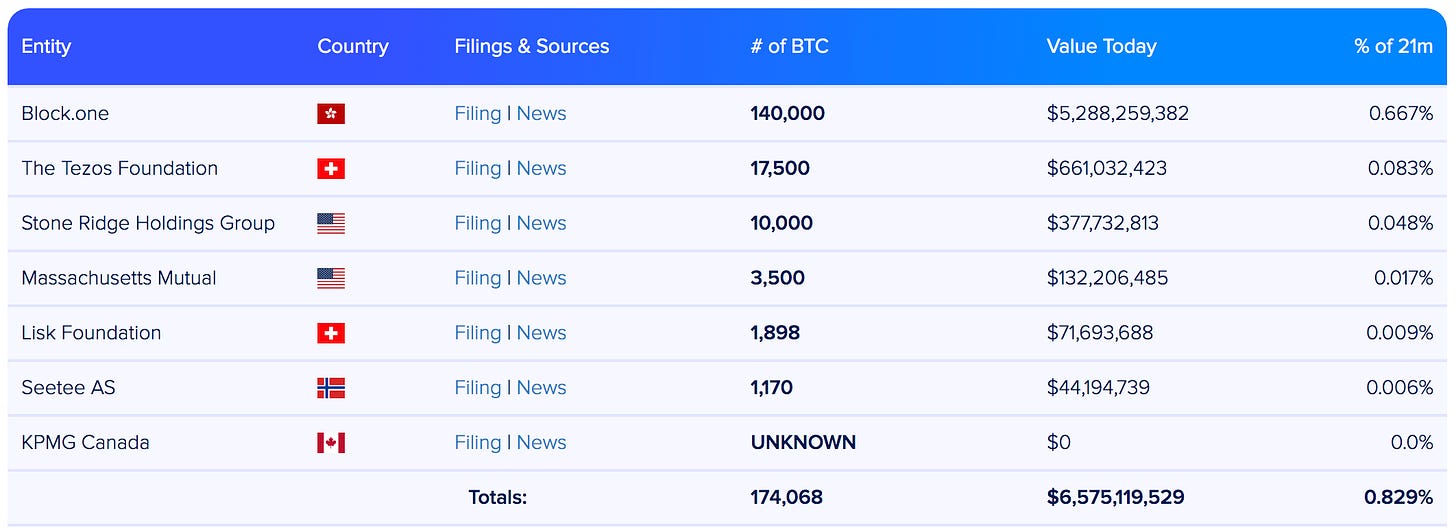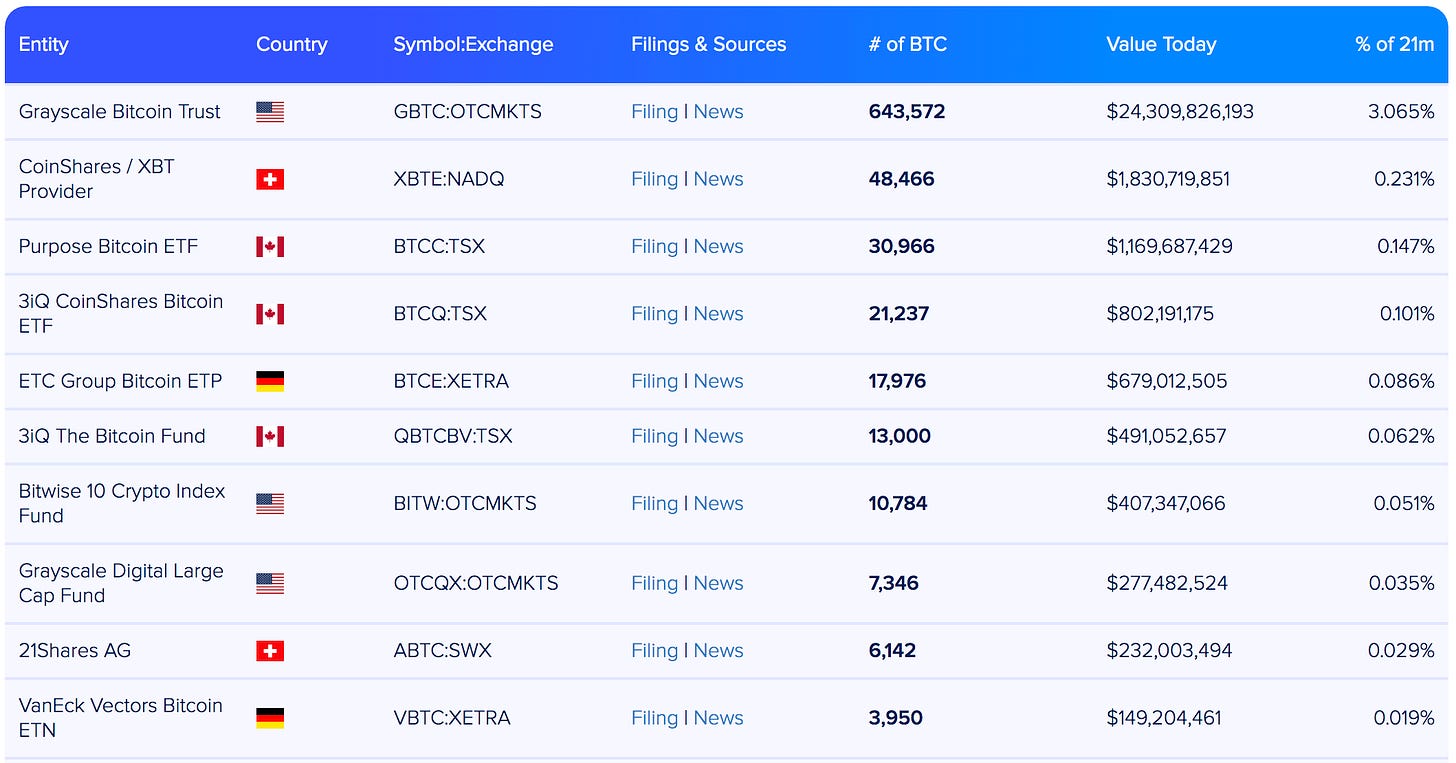Bitcoin Wealth Is Becoming More Evenly Distributed Over Time 1/4
How bitcoin wealth is becoming more evenly distributed over time
Widespread Estimates Of Individual Bitcoin Ownership Concentration Are Oversimplified And Irrelevant.
This content is for informational purposes only, you should not construe any such information or other material as investment, financial, or other advice.
Individual Bitcoin holders’ ownership distribution has been a highly debated topic since its inception. Alarming numbers indicating heavy Bitcoin wealth concentration have been circulating around for several years.
In this article, I examine if those widespread estimates are true. Besides that, I highlight other important information when it comes to Bitcoins wealth distribution among its users. I attempt to put these matters into a broader context.
A quick overview of the main chapters:
- Bitcoin: Enabling independent and unprecedented real-time forensic analysis
- Calculating individual Bitcoin holders wealth distribution: Essential variables
- Analysis of commonly cited news regarding Bitcoin wealth concentration
- Bitcoins early distribution history
- How Bitcoin wealth distribution has changed over time
- Global wealth distribution trends
- Wealth distribution of other cryptocurrencies
- Conclusion
If you find any wrong assumptions and/or conclusions made in this article, please reach out to me so that the article can be continuously improved upon. In this way, the article becomes a more reliable source for other readers over time.
1. Bitcoin: Enabling independent and unprecedented real-time forensic analysis
The transparent and immutable nature of the blockchain allows unprecedented real-time analysis, as was not possible with any other monetary system in history. The sheer amount of unaltered historic data that can now be aggregated, visualized, and interpreted from the Bitcoin blockchain teleports economic analysts into a new world – uncharted territory. This enables posthoc analyses of large-scale market behavior. The capability of reliably interpreting the data – on the other hand – is not seldomly overestimated by researchers and journalists, which will remain immediately relevant for this article when looking into the often cited claims of Bitcoin ownership concentration.
I provide just two examples of real-time datasets available to the interested Bitcoin observer in the next paragraphs (1.1. and 1.2.):
- Circulating and maximum supply
- Bitcoin monetary inflation
These examples showcase the transparency of the network, but also some of the limitations of interpreting that data.
1.1. Circulating and maximum supply
Anyone interested can independently verify the currently existing Bitcoin supply (~18,95 million)1 and the maximum supply of almost 21 million.2 With gold, in comparison, we can only estimate the below-ground stock reserves (~57,000 metric tons)3 and we trust how much is currently held in various vaults worldwide (which, of course, are independently audited – the difference being: it cannot be audited by anyone at any given time). The US has the largest gold reserves in the world with approximately 8,133 metric tons,4 which may be audited every five years if the “Gold Reserve Transparency Act of 2021” (H.R.3526) goes through some time in the future.5 With fiat currencies, like the US Dollar or the Euro, the circulating supply cannot be audited in real-time independently and transparently, because the architecture of the system does not enable such features, but also because supply exists both in the digital and physical realm. E.g., to learn about the circulating supply of physical Euro banknotes and coins, one can look into the reports of the European Central Bank, which are updated on the 14th day of every month.6 With Bitcoin, on the other hand, the entire ledger is updated roughly every 10 minutes. Although the circulating supply of Bitcoin can be precisely verified at any given point in time, it is important to note that 12 to 20% of those Bitcoins are estimated to be lost (more on this in 2.4.).7 This is one of the numerous examples that showcase a paradox of Bitcoins transparency; Yes, everything is out in the open, but no, we cannot calculate everything with these numbers.
1.2. Bitcoin monetary inflation
The Bitcoin protocol, including the rate of production, is publicly available for everyone to audit at any given time.8 Precisely 6,25 Bitcoins are produced on average every 10 minutes until the next block halving occurs in ~813 days,9 after which the production rate equals 3,125 Bitcoins per 10 minutes. This process of block halvings continues until all ~21 million Bitcoins are mined. The monetary inflation rate is currently at 1,79%10 and it is highly predictable (e.g. ~0,1% in 2034 and ~0,003% in 2058).11
Critical voices will argue that these rules can be changed in the “book of Bitcoin rules”, therefore it is important to understand how rule changes are implemented. In short, no single entity or small group of entities can change the rules. No matter how many Bitcoins you have in your possession, you do not have more “voting” power over other voices – the same goes for miners.
In the end, the community as a whole can never be forced to adopt undesirable changes to Bitcoin. Should a bad actor or group thereof take Bitcoin in a poor direction, the community can rally behind the better version of the project and choose their software. With the community’s economic activity taking place on the better version of the project, the bad actors would find themselves maintaining an empty blockchain while their supporting miners waste computational resources on worthless coins.12
Specifically, the monetary inflation rate and the capped supply of ~21 million units are without a doubt the two “rules” of the protocol that will be the very last to ever be altered – if those two rules were to be changed, two main value propositions of Bitcoin would be immediately diminished, resulting in the devaluation of Bitcoin itself. That would be similar to asking everyone to burn all their money and then 95% of people doing exactly that. On top of that, the original chain with the superior traits (here: fixed supply and predictable rate of production) remains to exist.
2. Calculating individual Bitcoin holders’ wealth distribution: Essential variables
Although various Bitcoin datapoints are publicly recorded and stored on an immutable ledger, interpreting some of that data – as mentioned – is not as easy as it seems at first glance. A prime example of this is to what degree the ownership of individual Bitcoin owners is concentrated. Providing rough estimates of the individual Bitcoin investors’ ownership concentration is a non-trivial task – Pinpointing it is impossible. In the next chapters, I elaborate on why this is an impossible task. For that matter, we will take a closer look at some of the variables that are important to consider when attempting to calculate the ownership concentration. Almost all of the following variables heavily skew the distribution of Bitcoin ownership in a more concentrated fashion when not accounted for in the calculation.
2.1. Exchange wallets
Exchange wallets account for millions of individual users. Today, only four Bitcoin addresses with more than 100,000 Bitcoins exist.13
All four of these “accounts” belong to exchanges, including the third richest address (1P5ZED), which has been thoroughly analyzed by many different sources (most recently in the working paper I examine in chapter 3.3.).14

Two years ago, in January 2020, there were seven Bitcoin addresses with 100,000 BTC or more. All seven belonged to exchanges.15
Not accounting for exchange addresses heavily skews the distribution of Bitcoin ownership in a more concentrated fashion. A significant amount of media publications reporting on Bitcoin ownership concentration have not considered this very basic variable in their estimates which we will see further down the article (Chapter 3.). Pinpointing the exact number of cryptocurrency exchanges is a significant challenge in itself, which is highlighted in 2.10.
2.2. Users can have multiple addresses
A single Bitcoin address does not equal a single Bitcoin user. A single Bitcoin user can easily create hundreds of wallet addresses and distribute their individual holdings across these addresses with ease. It is also common practice to create a new address every time a user, an exchange, or a miner receives a new transaction.
The following graphic – with not-up-to-date numbers from 2018 – visualizes this matter; 25 million private wallets with 460 million addresses in total.16
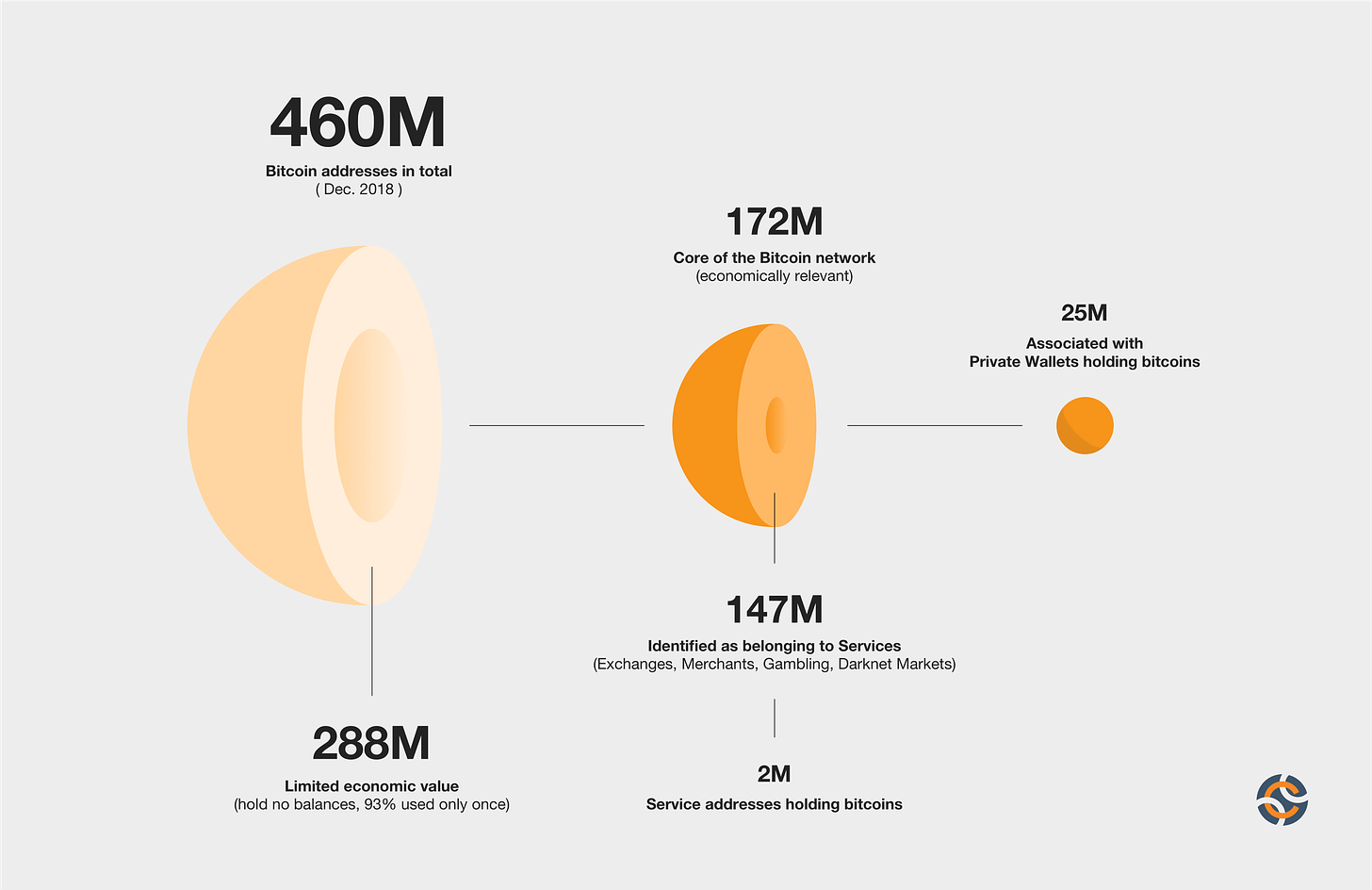
To account for this, methods of so-called “address clustering” have been introduced in the past, which are becoming more sophisticated over time.
“The goal of address clustering is to group addresses into clusters such that each cluster contains the addresses under the control of one user.”17
There are basically two most widely used methods for Bitcoin address clustering:
“One is based on the multiple input addresses of transactions. The other is based on one-time change addresses.”18
Yet again, significant limitations to identifying address clusters in a reliable fashion are prevalent. The key limitation of clustering methods is that it is difficult to judge the quality of the suggested clustering heuristic due to a lack of large-scale truth labels indicating which addresses genuinely belong to the same user. Additionally:
[…] many addresses could still fail to be clustered into a single entity. After all, not all heuristics and clustering algorithms will always be immediately triggered, especially if coins don’t move on-chain.19
The third method for clustering Bitcoin addresses, a “reuse-based heuristic” described in a research paper in 2020, shows that it is a more powerful method for address clustering:20
“[…] the ratio of address reduction contributed by it is approximately 45.12% on average.”
These examples provide us with a sneak preview of how much the results for calculating individual Bitcoin ownership depend on the methodology used – and many more variables are coming up in the next chapters.
2.3. Peeling Chains
Additionally, to obfuscate the tracing of Bitcoins, transactions are often channeled through many different addresses, resulting in so-called peeling chains.21 This is a common practice for criminals, e.g. as was done after the Bitfinex hack of 2016.22
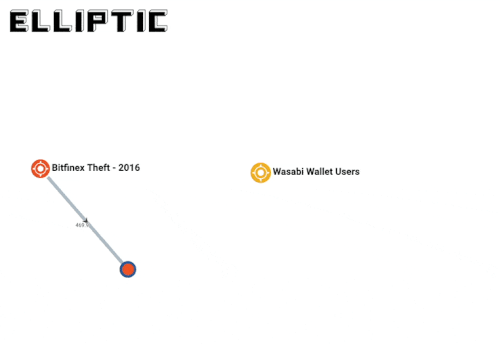
The peeling chains technique is also commonly used by other entities:
It is seen after large transactions from exchanges, marketplaces, mining pools and salary payments. In a peeling chain, a single address begins with a relatively large amount of bitcoins. A smaller amount is then peeled off this larger amount, creating a transaction in which a small amount is transferred to one address, and the remainder is transferred to a one-time change address. This process is repeated – potentially for hundreds or thousands of hops […].23
In the working paper examined in chapter 3.3., the researchers found that 256 million addresses are associated with peeling chains.24
2.4. Public and private companies
In 2021 something which was unimaginable just a few years ago, happened: A tiny wave of companies added Bitcoin to their balance sheets.25
In total, public companies hold an estimated amount of ~256,000 BTC. Private companies currently hold more than 174,000 BTC.26
The wallet addresses of these companies are, of course, confidential – they are not publicly known. Most likely they follow best-practice solutions and store their BTC with cold custodial services companies geared for institutions and large amounts. The Bitcoin holdings of public and private companies currently account for more than 2,2% of Bitcoins circulating supply – a significant amount to exclude when attempting to roughly estimate individual Bitcoin holders’ wealth concentration. These wallets often “behave” like individual investor wallets – buying and holding the digital asset – presenting a significant challenge to identify them.
2.5. Bitcoin Funds, ETFs, and ETPs
Since the “ProShares Bitcoin Strategy ETF” became the first Bitcoin-pegged ETF to debut on U.S. markets, several others have followed. The leader of the pack with more than 643,000 BTC is, without doubt, the “Grayscale Bitcoin Trust” fund.27 Often mislabeled as an ETF, Grayscale is the largest Bitcoin investment vehicle on the planet. The Trust’s BTC are stored in cold storage with the qualified custodian Coinbase, according to their own factsheet.28 A company representative commented that they have filed to convert their fund “into a Bitcoin Spot ETF, the application is under review until July 2022.”29 Bitcoins held by funds, ETFs, and ETPs total ~814,000 BTC, which is almost 4% of the total circulating Bitcoin supply.30
2.6. Countries and governments that hold Bitcoin
The small east-European country of Bulgaria apparently holds a whopping ~1% of the circulating Bitcoin supply.31
This news stem from a press release of May 2017 from the Southeast European Law Enforcement Center, in which the authorities have seemingly seized more than 213,000 BTC from a network of criminals.32 The rumor that Bulgaria holds this vast amount of Bitcoins has since spread throughout the global crypto community. But it is unclear if the government has ever really seized this amount of BTC, held onto them since then, or perhaps sold parts of these positions. An article from the Bitcoinist claims “Bulgaria sold all its BTC”,33 but this statement relies on an article from a local news publication dated 1st of April 2018 (April Fools) – and the article is rather sarcastically written (e.g. suggesting to buy a squadron of new aircraft for the army). From my personal “scratching-the-surface” research, it looks like the Bulgarian authorities never actually confiscated any Bitcoin funds:
The information about the confiscated crypto funds was later denied by the head of the Specialized Prosecutor’s Office, Ivan Geshev, now serving as Bulgaria’s Prosecutor General, who attributed the false claim to SELEC. His statement was also supported by Ivailo Spiridonov, then director of the country’s organized crime combating agency, GDBOP.34
There is reasonable doubt of Bulgaria’s Bitcoin holdings, meaning they could be entirely crossed out of the above table. It is important to note that other countries holding BTC are not listed in the table, e.g. the USA and China. There are several cases where the Chinese and US confiscated a significant amount of Bitcoin from criminals – perhaps the most elegant form of acquiring the digital asset. Last year, Chinese authorities seized almost 195,000 BTC from the PlusToken Ponzi crackdown (more than 1% of the circulating Bitcoin supply).35 In recent news this month, the U.S. Department of Justice announced they have seized $3.6 billion worth of Bitcoin linked to the 2016 hack of the crypto exchange Bitfinex.36 The DOJ says this is the largest financial seizure by U.S. law enforcement. The ~94,640 BTC are held on the address bc1qazcm763858nkj2dj986etajv6wquslv8uxwczt, which is currently the fifth richest single Bitcoin address in existence.37 The US Marshals Service is in charge of auctioning off the government’s Bitcoin holdings – it has seized and auctioned over 185,000 BTC since 2014 (potential USD gains missed: ~6,4 billion USD)38 – an example of such an auction can be seen here.39
It is also worth mentioning that early Bitcoin adopter and software developer Gavin Andresen visited the CIA headquarters as early as June 2011 to give a presentation about Bitcoin40 – there is no conspiracy to be constructed out of this simple presentation – but it cannot be ruled out that government agencies like these have since accumulated a substantial amount of Bitcoin holdings. The summer of 2011 was indeed an interesting time in Bitcoins price history: a “flash crash” from 32 USD to 0,01 USD occurred.41
In summary, it is unclear how many Bitcoins are held by which governments (El Salvador being an exception). The purpose of these subchapters 2.1. to 2.16. is not only to show the number of variables to account for when calculating wealth concentration but also how fogged the variables themselves can be. This becomes quite clear with this particular variable, as numbers vary wildly depending on the source one looks into. To calculate individual investors’ wealth concentration in Bitcoin, these numbers (which are unknown!) would need to be extracted and/or broken down to the individual number of users represented by these holdings. If ignored, the “calculated” estimate will automatically result in a concentrated number far off from reality.
2.7. Lost Bitcoins
Another essential variable to include in the equation is lost Bitcoins. Lost Bitcoins refer to BTC that are not any more accessible to the user – e.g. because the owners lost their private key or passed away without passing on this necessary information beforehand. In Bitcoins’ early days, it was often seen as nerd money or some funny form of an experiment – remember a single Bitcoin was worth nothing for the first years. This resulted in a high level of ignorance when it comes to Bitcoin storage security. A well-known example of this is a young man who accidentally threw away his hard drive with the private keys of 7,500 Bitcoins (today worth more than 260 million USD).42
Several of the richest Bitcoin addresses haven’t seen a single outgoing transaction for over a decade.43 For example, in the Bitcoin rich list currently residing in 30th place, the address 12ib7dApVFvg82TXKycWBNpN8kFyiAN1dr worth more than 1,3 billion USD as of this writing (31,000 BTC), had its last outgoing transaction almost 12 years ago (July 2010). In fact, 10% of all existing Bitcoins have not been moved for over a decade, as the blockchain analytics company Glassnode finds.44 It remains speculative if these BTC are lost or not, but it is not unlikely. John W. Ratcliffe compiled a Spreadsheet of “Dormant Bitcoin Addresses”, which could have been lost. The leading blockchain analytics firm Chainalysis estimates a lower bound of 2,3 million Bitcoins lost and an upper bound of 3,7 million.45
The unknown Bitcoin inventor Satoshi Nakamoto mined between ~1,000,00046 to 1,125,150 Bitcoins.47 It is unclear if Satoshi Nakamoto is still alive and/or has access to the keys. The first Bitcoin transaction, sent by Satoshi, was received by Hal Finney, who passed away in 2014 and is now cryopreserved.48 Hal Finney is often perceived as the most likely person to have been Satoshi Nakamoto, because he was the first person (other than Nakamoto himself) to use the software, file bug reports, and make improvements.49 It is not unlikely that Satoshis’ entire Bitcoin stack is “lost”. I elaborate on this statement in chapter 4.
Other, less significant, examples of lost Bitcoins include so-called “burn addresses” which are verifiable unspendable. An example for this weird phenomenon are the addresses “1BitcoinEaterAddressDontSendf59kuE”50 and “1CounterpartyXXXXXXXXXXXXXXXUWLpVr”,51 to which you can send your BTC if you feel like burning money – more than two-thousand Bitcoins have been sent to these addresses in the past years.52 You can see a list of burn addresses here.
Although the exact total number of lost Bitcoins remains to be highly speculative, it is grossly negligent to simply dismiss this important variable when calculating wealth concentration (12-20% of all BTC).
2.8. Wrapped BTC
Wrapped BTC are a tokenized representation of Bitcoin. This enables them to be used on blockchains to which they are not native (e.g. the Ethereum ecosystem).53
Currently, there are around 263,000 BTC wrapped in the WBTC ERC20 token.54
The custodian stores those BTC on wallets that all have a balance of at least 1,000 BTC. Again, given that these coins belong to many investors, the ownership of BTC disperses further across entities.55
This variable is immediately relevant to the widespread claim that 0,01% of individual Bitcoin investors control 27% of the circulating Bitcoin supply (analyzed in chapter 3.3.) because the working paper on which these numbers rely analyzes the top 2,258 Bitcoin addresses with at least 1,000 BTC. Wrapped BTC are not mentioned in the paper, it is unclear if these were accounted for.
2.9. Hacked exchanges
The infamous Bitcoin exchange Mt. Gox has been hacked several times. One of those hacks occurred in March 2011, in which ~80,000 BTC were stolen.56 Hackers transferred the full amount to a single BTC address:57 1FeexV6bAHb8ybZjqQMjJrcCrHGW9sb6uF.
Until today, over a decade later, this address has no single outgoing transaction, which could signal that the hackers have lost the private key to access the digital assets currently worth more than 2.8 billion USD. This address is currently the 9th richest Bitcoin address.58 Authorities working hand in hand with forensic blockchain analytics companies are becoming more sophisticated in tracking, identifying, and seizing the digital asset BTC from criminals – as the report “Statement of Facts” published by the Department of Justice this month evidently shows.59 The BTC in the “1Feex” address are either “lost” or the hackers will be caught when attempting to launder them (e.g. via peeling chains described in 2.3.). The chance that these criminals will successfully launder the BTC sometime in the future without being caught is minuscule. When attempting to calculate individual Bitcoin ownership concentration, this “1Feex” address might currently be factored in as a single user holding these assets – but given the information outlined in this paragraph, I believe this to be an oversimplified approach. Rather, these BTC can be added in the “lost” column or they will be seized in the future and perhaps even returned to the thousands of users to which they initially belonged.
2.10. Other variables
The variables summarized in this subchapter are not necessarily less important than the ones mentioned above, but this article should not take a full hour to read. Other variables to account for when calculating individual Bitcoin ownership concentration include, but are not limited to:
Mining pools and institutional miners
The chances of an individual miner finding a new block are minuscule. Therefore, individual miners are oftentimes part of a “mining pool”, in which thousands of miners come together to combine their hash rate and increase the probability of ‘finding a new block’. They are essentially trying to be the first to solve a ‘hash puzzle’ by finding the right nonce to validate a new block. First to find the nonce (which occurs roughly every 10 minutes) is rewarded with the block subsidy of 6.25 BTC and all transaction fees on that particular block. Whenever a member of a mining pool solves the hash puzzle, the block reward is distributed among its participants. Tracking the distribution of mining rewards from the pools to the miners is a non-trivial task and the methodology used to achieve this is not seldomly based on unverified (and/or outdated) algorithms.
Dust wallets
Bitcoin dust refers to tiny wallet holdings that are economically unspendable. It costs more (in transaction fees) to spend than the value associated with the Bitcoin address. Users end up with dust in their wallets due to poor transaction management or by receiving dust deposits that were not requested (e.g. via “dust attacks”).60 Assuming that dust wallets represent single users and/or not clustering dust wallets enough, results in a total ‘Bitcoin user number’ far too high off from reality, which in return results in a more concentrated number of individual Bitcoin holders’ wealth distribution.
OTC brokers
There are specific Bitcoin OTC (Over the Counter) brokers that deal with clients looking to place large orders (often starting at 50k USD). Normal methods for obtaining Bitcoin aren’t necessarily ideal for high volume transactions, due to trading fees and a limited supply on Bitcoin exchanges. Some investors choose not to have a significant impact on Bitcoin’s price and therefore avoid placing massive ‘Buy’ orders on exchanges.61 Identifying the wallet addresses of OTC brokers presents a significant challenge. It is likely that several addresses belonging to OTC brokers are among the richest Bitcoin addresses – resulting in a significantly more even distribution across single users when accounted for correctly.
Unknown exchange cold wallets
It is difficult to determine the exact number of Bitcoin exchanges since these are not regulated in some countries and therefore do not need to register with any centralized authority. The estimated number of exchanges varies wildly depending on the source you inspect. I’ve stumbled upon numbers ranging from 313 up to 866. On top of not knowing how many exchanges exist, it is incredibly hard to identify the cold wallets of known exchanges:
Because cold wallets typically consist of few addresses and send and receive funds only infrequently, the default clustering algorithm in many cases does not link them to the corresponding hot wallets of exchanges. Therefore, identifying cold wallets presents a significant challenge.62
Of course, several of these exchanges only have a low trading volume and perhaps relatively small wallets, but these small numbers quickly add up to be relevant when calculating individual BTC ownership concentration.
Financial services corporations and asset managers
Fidelity, an American multinational financial services corporation and one of the largest asset managers in the world ($4.9 trillion in assets under management as of 2020)63 started mining Bitcoins in 2015.64 BlackRock, the world’s largest asset manager (~10 trillion USD in assets under management as of January 2022),65 invested almost 400 million USD into the two US-based mining institutions Marathon Digital Holdings and Riot Blockchains last year (joining Vanguard Group and Fidelity).66 These indirect investments into Bitcoin via Bitcoin mining stocks enables the mining institutions to expand their mining operations (increasing the hash rate), resulting in more Bitcoins being mined by them. For example, Marathon Digital Holdings currently holds ~8,600 BTC.67 BlackRock has further exposure to Bitcoin via its 7.3% stake in Microstrategy.68 Although the beforementioned asset managers might not be holding Bitcoins directly yet, others, like the Soros Fund Management, own “some coins”.69 It remains unclear how many asset managers control how many BTC.
Even more variables
Many other custodial wallet services (third-parties that hold Bitcoin on behalf of their owners) and more variables to account for when calculating individual Bitcoin ownership concentration exist.70 Some of these include, but are not limited to:
- Payment processors (e.g. BitPay)
- Bitcoin gambling sites (e.g. SatoshiDice)
- Charity funds (e.g. The Giving Block)
- Crowdsourced wallets (e.g. Tallycoin)
- Family offices
Did you like the first part of this article? Look forward to the second part!
You can get more information about the author -Michael Weymans- here on LinkedIn.
A previously published article by this author, can be found here.
Original source: https://blog.bitbeginner.com/p/70b13407-7a78-4e56-acd1-e1365b8adbd9?s=r




